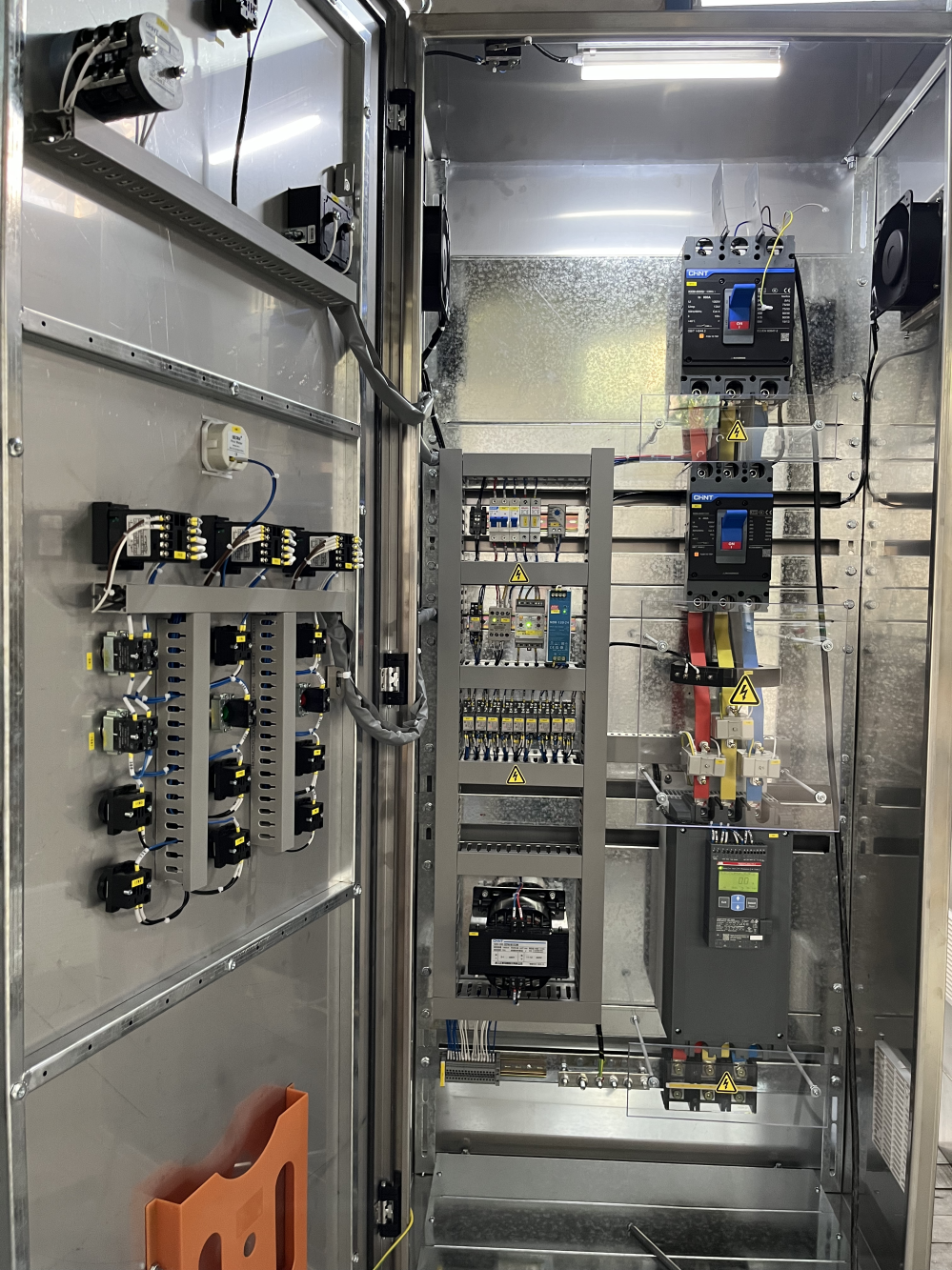Soft Start Control Cabinets play a vital role in modern industries by ensuring smooth motor operations and protecting equipment from damage. These systems reduce inrush currents and limit torque, which enhances efficiency and extends the lifespan of machinery. As industries evolve, the demand for advanced technologies continues to grow. This raises a critical question: How will emerging trends and innovations redefine the capabilities of these essential systems in the future?
Overview of Soft Start Control Cabinets
Purpose and Functionality
Soft Start Control Cabinets serve as essential components in industrial systems. They regulate the initial power surge when motors start, ensuring a gradual increase in voltage. This process minimizes inrush currents and reduces mechanical stress on equipment. By controlling the torque and speed during startup, these cabinets protect motors from damage and extend their operational lifespan. Industries rely on these systems to maintain smooth operations and prevent costly downtime caused by equipment failure.
The functionality of these cabinets goes beyond motor protection. They enhance system reliability by preventing electrical disturbances that could affect other connected devices. Additionally, they provide operators with greater control over motor performance, enabling precise adjustments to meet specific operational requirements. This versatility makes them indispensable in various industrial applications.
Benefits in Industrial Applications
Soft Start Control Cabinets offer numerous advantages that improve efficiency and productivity in industrial settings. One of their primary benefits is energy savings. By reducing the power surge during motor startup, these cabinets lower energy consumption and contribute to cost savings over time. This feature aligns with the growing emphasis on energy efficiency in modern industries.
Another significant benefit is the reduction of wear and tear on mechanical components. The controlled startup process minimizes stress on belts, gears, and other parts, leading to fewer maintenance requirements and longer equipment lifespans. This not only reduces operational costs but also enhances overall system reliability.
Industries also value these cabinets for their ability to improve safety. By limiting torque and controlling motor acceleration, they reduce the risk of accidents caused by sudden movements or equipment malfunctions. This makes them a critical component in environments where safety is a top priority.
Current Market Trends
The market for Soft Start Control Cabinets continues to evolve, driven by advancements in technology and changing industrial demands. One notable trend is the integration of smart technologies, such as the Internet of Things (IoT) and cloud computing. These innovations enable real-time monitoring and remote control, allowing operators to optimize performance and address issues proactively.
Energy efficiency remains a key focus in the market. Manufacturers are developing more compact and sustainable designs to meet the growing demand for environmentally friendly solutions. This shift reflects the increasing importance of sustainability in industrial operations.
Another emerging trend is the adoption of modular and scalable designs. These configurations provide greater flexibility, allowing businesses to customize their systems based on specific needs. This adaptability is particularly valuable in industries undergoing rapid technological changes.
The market also highlights the importance of enhanced automation and control capabilities. As industries move toward greater automation, Soft Start Control Cabinets play a crucial role in supporting seamless integration with advanced systems. This positions them as a vital component in the future of industrial automation.
Emerging Trends in Soft Start Control Cabinets
Integration with IoT and Cloud Computing
The integration of IoT and cloud computing has revolutionized industrial systems. Soft Start Control Cabinets now leverage IoT to enable real-time data collection and monitoring. Sensors embedded in these cabinets gather critical information, such as motor performance and energy consumption. This data allows operators to identify inefficiencies and optimize operations.
Cloud computing enhances this process by providing a centralized platform for data storage and analysis. Operators can access system insights remotely, ensuring timely decision-making. This capability reduces downtime and improves overall productivity. Additionally, cloud-based systems support predictive maintenance by identifying potential issues before they escalate. This proactive approach minimizes repair costs and extends equipment lifespan.
Industries benefit from the scalability of IoT and cloud solutions. Businesses can expand their systems without significant infrastructure changes. This flexibility makes these technologies essential for adapting to evolving industrial demands.
AI-Driven Optimization and Predictive Analytics
Artificial intelligence (AI) has become a driving force in optimizing industrial processes. Soft Start Control Cabinets equipped with AI algorithms analyze operational data to enhance performance. These systems adjust motor settings automatically, ensuring optimal efficiency under varying conditions.
Predictive analytics, powered by AI, plays a crucial role in maintenance strategies. By analyzing historical data, these systems predict potential failures and recommend preventive measures. This reduces unplanned downtime and increases system reliability. Operators gain valuable insights into equipment health, enabling better resource allocation.
AI also supports energy management. Intelligent algorithms identify patterns in energy usage and suggest adjustments to minimize waste. This aligns with the growing emphasis on sustainability in industrial operations. The combination of AI and predictive analytics transforms Soft Start Control Cabinets into intelligent tools for modern industries.
Focus on Energy Efficiency and Sustainability
Energy efficiency has become a top priority for industries worldwide. Soft Start Control Cabinets contribute significantly to this goal by reducing energy consumption during motor startup. Advanced designs now incorporate low-wear semiconductor technology, which enhances switching efficiency and minimizes energy loss.
Sustainability efforts drive the development of eco-friendly cabinet designs. Manufacturers focus on creating compact systems that use fewer materials without compromising performance. These innovations align with global initiatives to reduce environmental impact.
Industries also prioritize renewable energy integration. Soft Start Control Cabinets support compatibility with renewable energy sources, such as solar and wind power. This capability ensures seamless operation in sustainable energy systems. By promoting energy efficiency and sustainability, these cabinets play a vital role in achieving industrial and environmental goals.
Key Technologies Shaping the Future
Intelligent Monitoring and Diagnostics
Intelligent monitoring systems have transformed how industries manage equipment. These systems collect real-time data from Soft Start Control Cabinets, providing operators with detailed insights into motor performance and system health. Sensors embedded in the cabinets track parameters such as voltage, current, and temperature. This data enables early detection of anomalies, preventing potential failures.
Diagnostics tools analyze the collected data to identify inefficiencies or irregularities. Operators can use these insights to make informed decisions, improving overall system reliability. Predictive maintenance becomes possible with intelligent diagnostics, as it allows industries to address issues before they escalate. This approach reduces downtime and extends the lifespan of equipment.
The integration of intelligent monitoring also enhances operational transparency. Industries can track performance metrics and ensure compliance with safety standards. By leveraging these technologies, businesses achieve greater efficiency and maintain uninterrupted operations.
Enhanced Cybersecurity for Industrial Systems
The increasing reliance on digital technologies has made cybersecurity a critical concern for industrial systems. Soft Start Control Cabinets, now equipped with advanced connectivity features, face potential risks from cyber threats. Enhanced cybersecurity measures protect these systems from unauthorized access and data breaches.
Encryption technologies safeguard sensitive information transmitted between devices. Firewalls and intrusion detection systems add an extra layer of protection, ensuring that only authorized personnel can access the control cabinets. Regular software updates and patches address vulnerabilities, keeping the systems secure against evolving threats.
Industries also implement strict access controls to limit user permissions. Multi-factor authentication ensures that only verified individuals can operate or modify the systems. These measures reduce the risk of malicious activities and maintain the integrity of industrial operations.
Cybersecurity training for personnel further strengthens defenses. Employees learn to recognize potential threats and follow best practices for system security. By prioritizing cybersecurity, industries protect their investments and ensure the safe operation of critical systems.
Modular and Scalable Designs for Flexibility
Modular designs have redefined the adaptability of Soft Start Control Cabinets. These designs allow industries to customize their systems based on specific operational needs. Businesses can add or remove modules without disrupting existing setups, ensuring seamless scalability.
Scalable designs support industries experiencing growth or technological advancements. Companies can expand their systems to accommodate new equipment or processes. This flexibility reduces the need for complete system overhauls, saving time and resources.
Modular configurations also simplify maintenance and repairs. Operators can replace individual modules instead of addressing the entire system. This approach minimizes downtime and ensures continuous operations. Additionally, modular designs enhance compatibility with emerging technologies, enabling industries to stay ahead in a competitive market.
Industries benefit from the cost-effectiveness of scalable solutions. Businesses invest in systems that grow with their needs, avoiding unnecessary expenses. Modular and scalable designs empower industries to adapt to changing demands while maintaining efficiency and reliability.
Industry Applications of Emerging Trends
Manufacturing and Smart Factories
Manufacturing industries increasingly adopt advanced technologies to enhance productivity and efficiency. Soft Start Control Cabinets play a pivotal role in this transformation. These cabinets ensure smooth motor operations, reducing mechanical stress on equipment. This capability minimizes downtime and extends the lifespan of machinery, which is critical in high-demand production environments.
Smart factories leverage the integration of IoT and AI within these cabinets. Real-time monitoring enables operators to track motor performance and energy consumption. Predictive analytics identifies potential issues before they disrupt operations. This proactive approach improves reliability and reduces maintenance costs. Modular designs also allow manufacturers to scale their systems as production needs evolve, ensuring flexibility in dynamic industrial settings.
Energy efficiency remains a priority in manufacturing. Soft Start Control Cabinets contribute by lowering energy consumption during motor startup. This aligns with sustainability goals and reduces operational costs. By integrating these cabinets, smart factories achieve higher efficiency, safety, and adaptability in their processes.
Oil and Gas Operations
The oil and gas sector relies heavily on robust and reliable equipment. Soft Start Control Cabinets provide essential support by protecting motors from damage caused by sudden power surges. This protection ensures uninterrupted operations in critical processes such as drilling, pumping, and refining.
Harsh environments in oil and gas operations demand durable and efficient systems. Advanced cabinets equipped with intelligent monitoring detect anomalies in real time. Operators receive alerts about potential issues, enabling timely interventions. This reduces the risk of equipment failure and costly downtime.
Energy efficiency is vital in this energy-intensive industry. Soft Start Control Cabinets optimize motor performance, reducing energy waste. Their compatibility with renewable energy sources further supports the industry's transition toward sustainable practices. Enhanced cybersecurity features safeguard these systems from cyber threats, ensuring the safe and secure operation of critical infrastructure.
Water Treatment and Utility Management
Water treatment facilities and utility management systems depend on reliable motor control for pumps, compressors, and other equipment. Soft Start Control Cabinets ensure smooth startups, preventing mechanical stress and extending equipment life. This reliability is crucial for maintaining consistent water supply and quality.
IoT integration enhances the functionality of these cabinets in utility management. Real-time data collection allows operators to monitor system performance remotely. Predictive maintenance capabilities identify potential issues, reducing Service interruptions. These features improve operational efficiency and ensure the continuous delivery of essential services.
Energy efficiency is a key focus in water treatment. Soft Start Control Cabinets reduce energy consumption during motor startup, aligning with sustainability goals. Their modular designs enable facilities to adapt to changing demands without significant infrastructure changes. By incorporating these cabinets, water treatment and utility systems achieve greater efficiency, reliability, and environmental responsibility.
Challenges and Considerations
Cost and Investment Concerns
The adoption of Soft Start Control Cabinets often requires significant financial investment. Businesses must allocate resources for the initial purchase, installation, and integration of these systems. Advanced features, such as IoT connectivity and AI-driven analytics, can further increase costs. For small and medium-sized enterprises (SMEs), these expenses may pose a barrier to adoption.
Operational budgets also need to account for long-term expenses. Maintenance, software updates, and potential upgrades contribute to ongoing costs. Companies must evaluate the return on investment (ROI) to justify these expenditures. Decision-makers often weigh the benefits of improved efficiency and reduced downtime against the upfront financial commitment.
To address these concerns, manufacturers and suppliers offer flexible financing options. Leasing programs and installment plans help businesses manage costs more effectively. Additionally, government incentives and subsidies for energy-efficient technologies can reduce the financial burden. Organizations must explore these opportunities to make informed investment decisions.
Compatibility with Legacy Systems
Integrating Soft Start Control Cabinets into existing industrial setups presents challenges. Many facilities operate with legacy systems that lack modern connectivity features. Ensuring compatibility between new and old equipment requires careful planning and technical expertise. Mismatched systems can lead to inefficiencies or operational disruptions.
Retrofitting older systems with advanced control cabinets often involves additional expenses. Customization may be necessary to bridge technological gaps. This process demands skilled technicians who understand both legacy and modern systems. Without proper integration, businesses risk underutilizing the capabilities of their new equipment.
Manufacturers address compatibility issues by designing adaptable solutions. Modular configurations and scalable designs enable seamless integration with diverse systems. Businesses should conduct thorough assessments of their existing infrastructure before implementing new technologies. Collaboration with experienced vendors and consultants ensures smoother transitions.
Maintenance and Skill Requirements
Maintaining Soft Start Control Cabinets requires specialized knowledge. Advanced features, such as IoT sensors and AI algorithms, demand technical expertise for troubleshooting and repairs. Industries must invest in training programs to equip their workforce with the necessary skills. Without proper training, operators may struggle to maximize the potential of these systems.
Regular maintenance is essential to ensure optimal performance. Tasks include inspecting components, updating software, and replacing worn parts. Neglecting these responsibilities can lead to system failures and costly downtime. Businesses must establish maintenance schedules and allocate resources for these activities.
The growing complexity of industrial systems increases the demand for skilled technicians. Recruiting and retaining qualified personnel becomes a priority for organizations. Partnerships with training institutions and certification programs can help address skill shortages. By prioritizing workforce development, industries can overcome maintenance challenges and ensure the reliability of their systems.
Future Outlook for Soft Start Control Cabinets
Transformative Potential in Automation and Efficiency
Soft Start Control Cabinets hold immense potential to revolutionize industrial automation and efficiency. These systems enable industries to optimize motor operations, reducing energy waste and mechanical stress. By integrating advanced technologies like artificial intelligence and IoT, they provide real-time insights into system performance. This capability allows operators to make data-driven decisions, improving productivity and minimizing downtime.
Industries increasingly rely on automation to meet growing demands. Soft Start Control Cabinets play a pivotal role in this shift by ensuring seamless motor control. Their ability to adapt to varying operational conditions enhances system reliability. As automation becomes more sophisticated, these cabinets will likely evolve to support even greater levels of precision and control.
Energy efficiency remains a critical focus for industries worldwide. Soft Start Control Cabinets contribute significantly by lowering energy consumption during motor startup. This aligns with global sustainability goals and reduces operational costs. Their transformative potential lies in their ability to combine efficiency with advanced functionality, making them indispensable in modern industrial systems.
Importance of Adapting to Evolving Industry Standards
The industrial landscape constantly evolves, driven by technological advancements and regulatory changes. Soft Start Control Cabinets must adapt to these shifts to remain relevant. Compliance with industry standards ensures their compatibility with emerging technologies and operational requirements. Manufacturers prioritize innovation to meet these evolving demands, developing systems that align with new benchmarks for safety, efficiency, and sustainability.
Global initiatives emphasize the importance of reducing environmental impact. Soft Start Control Cabinets support these efforts by incorporating energy-efficient designs and renewable energy compatibility. Industries adopting these systems demonstrate their commitment to sustainability, gaining a competitive edge in the market.
Adapting to industry standards also involves addressing cybersecurity concerns. As connectivity increases, protecting systems from cyber threats becomes essential. Enhanced security features ensure the safe operation of Soft Start Control Cabinets in digital environments. By staying ahead of industry trends, these systems continue to drive progress in automation and efficiency.
Soft Start Control Cabinets remain essential in advancing industrial efficiency and sustainability. These systems optimize motor operations, reduce energy consumption, and extend equipment lifespan, making them indispensable in modern industries. Emerging trends and technologies, such as IoT, AI, and modular designs, continue to reshape their capabilities, driving innovation and adaptability. Businesses must stay informed about these advancements to maintain competitiveness and operational excellence. Proactive adoption of these technologies ensures long-term benefits, including improved productivity, reduced costs, and alignment with sustainability goals.




